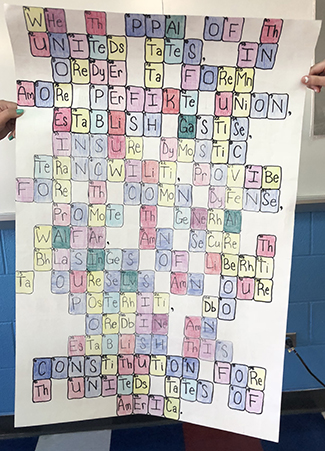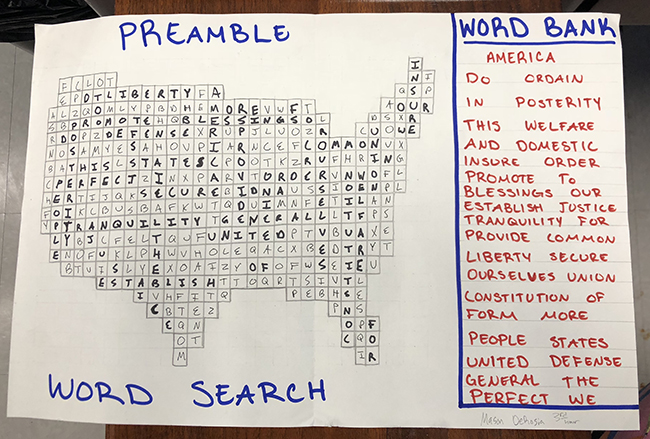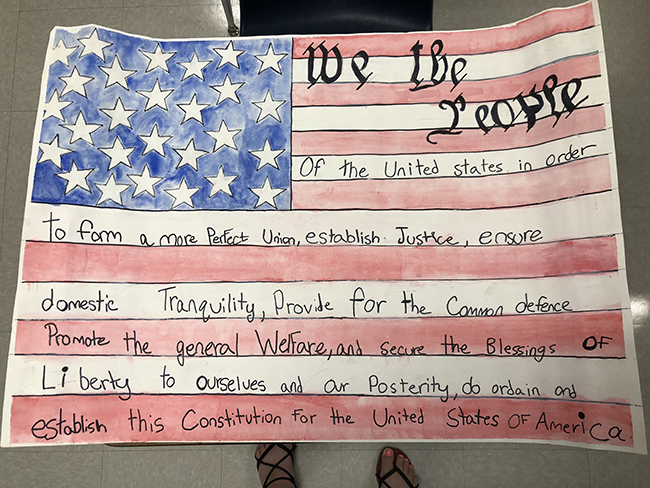September 17, 2018
By Kymberli Wregglesworth
Onaway High School
Throughout the sweltering summer of 1787, learned and landed men from 12 of the young nation’s 13 states suffered behind closed doors and windows to craft a solution to the multiple problems facing the republic. Through the careful planning and orchestration of James Madison, assisted by George Washington, the states were convinced to select delegates to attend a “Grand Convention” in Philadelphia intended to discover ways to improve the Articles of Confederation. Six states, including Virginia, Pennsylvania, New Jersey, North Carolina, Georgia and Delaware, chose their delegates to the convention before it was authorized by the Confederation Congress. The others, except for Rhode Island, which refused to send anyone, chose their delegates after the Congress officially endorsed the convention.

So what were the delegates actually asked to do? At the time, this was something of a contentious issue – it took a unanimous vote to amend the Articles, but the congressional act sounded quite broad: the delegates were meeting “for the sole purpose of revising the articles of Confederation” and reporting “such alterations and provisions” to preserve the Union. Were they supposed to make minor changes here and there, or were they to dispose of the Articles and begin again from scratch?
The problems of the Articles of Confederation were numerous, including no national executive or judiciary, no power to collect taxes, infighting among the states over interstate commerce, no power to raise an army and the necessity of a supermajority of nine out of thirteen states to pass any laws.
Edmund Randolph, then governor of Virginia, began the convention by offering up the Virginia Plan, authored by Madison, that proposed a three branch national government with a bicameral legislature representing the people in both houses. This was a major divergence from the wholly federal Confederation Congress, which represented only the states, and several states would not have it. They argued that the mandate issued by Congress was only to revise, and the Virginia Plan was a complete change, so they offered the federal New Jersey Plan instead.
As a stalemate between the two plans looked to derail the entire convention, Connecticut’s Oliver Ellsworth suggested a “partly national, partly federal” solution. A committee led by Elbridge Gerry of Massachusetts eventually developed what became known as the Connecticut Compromise, perhaps saving the fate of the nation. This compromise combined popular representation in the House of Representatives and equal representation of the states in the Senate. Unfortunately, this major compromise was not even the beginning of the end of the convention.
From representation, the delegates turned to the question of powers – which should be held by the states and which delegated to the national government? Which should be held by the executive? How should powers be divided among the three branches of the national government, and which checks should be given to each branch to protect the people from the tyranny of the other branches?
Additionally, the delegates wrestled with the issue of slavery. A dark cloud over the United States since before the Declaration of Independence, the sale of human beings would not be solved in the new Constitution, but the Founders did move toward ending this “peculiar institution” by providing an opening to abolish the international slave trade after 1808.
One of the final issues to be debated and settled had to do with the presidency – how the president would be chosen, for how long would he be elected, would he be eligible for re-election, and what would his powers be? The complicated and oft-misunderstood Electoral College would borrow from the example of the Connecticut Compromise, making the choice of president a partly national, partly federal affair.
During the last week, a few delegates campaigned for the addition of a Bill of Rights, and three walked away from the convention without signing due to its non-inclusion. Thirty-nine of the fifty-five attendees, from every state except Rhode Island, signed the final document, which was sent to the states for ratification. It is this same document that we look to today for guidance in governing our nation and it has survived with relatively few changes for over 200 years.
On the final day of the convention – what we now celebrate by Congressional mandate on September 17 as Constitution Day – Benjamin Franklin made an observation that many have found particularly poignant. George Washington sat in a chair with a sun carved on its back that many delegates discussed throughout the convention regarding whether it represented a rising or setting sun. Said Franklin, “I have often ... in the course of the Session ... looked at that behind the President without being able to tell whether it was rising or setting: But now at length I have the happiness to know that is a rising and not a setting Sun.”


Resource:
TeachingAmericanHistory.org/Convention/
Top photo source:
NPS.gov
Kymberli Wregglesworth is a Michigan Teacher of the Year Regional Finalist who teaches history at Onaway High School in Onaway Area Community Schools. She's also known as the superhero Pop Quiz, a member of The Educators.